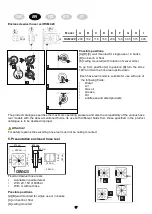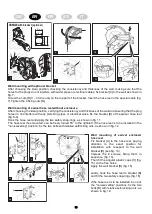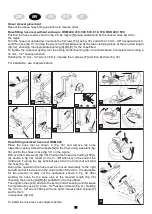
15
DE
EN
FR
ES
IT
•
This equipment is not intended for use in environments with oxygen concentrations higher than 21 vol.%.
•
This is not portable equipment or equipment to be transported by people.
Any use other than the intended context/useis excluded.
•
At least twice a year, check the efficiency of the spring.
•
Carry out a tightness test on the swivelling part and the connections.
•
Using a spray foam for detecting leaks.
•
Clean the fittings and the swivelling part.
•
Make sure the hose is in tact.
•
Check the wall or ceiling fixing of the hose reel and check the tightness of all the screws.
•
Also check the exterior surfaces for any corrosive phenomena or dangerous damage.
•
For applications in zones classified as Atex 1 or 21
the rewinding spring and joggle must be replaced after
15000 complete cycles (winding and rewinding) or after 10 years of service. In the case the classified area is
also a corrosive environment, the springs must be checked annually. The replacement of parts (e .g. seals,
gaskets, joint, rewinding spring, etc.) must only be carried out by qualified personnel: in fact, incorrect removal
and/or fitting of parts of the hose reel could cause malfunctions. In particular, opening of the spring cover casing
constitutes a potential danger for the operator if not carried out by specially trained personnel.
For the hose reels used with fluids such as air, water or gas oil, install a filter upstream of the hose reel in order
to prevent the entry of impurities which can cause the accumulation of electrostatic charges in the hose reel.
3. Maintenance and checks
TEST 3
TEST 2
TEST 1
TEST 3
TEST 2
TEST 1
•
Before commissioning the hose reel, check the earthing, in order to
guarantee protection against risks caused by an accumulation of
electrostatic charges. Check that the earthing cable is not damaged and
that the measured resistance of the tool, during the test shown in the figure,
is less than 50×10⁶ ohm (50MΩ). For category 3 hose reels carry out test
1. For category 2 hose reels carry out tests 1, 2, 3. Repeat the test
periodically.
•
Do not use naked flames or carry out hot work near the hose reel. Do not
expose the hose reel and the hose to heat sources.
•
The electrical system and electric equipment installed near the hose reel
must comply with the requirements of the classification in zones provided
for by ATEX. They must also comply with the current legal provisions in the
relevant country.
•
During cleaning of the connections or the internal parts in general, use
products compatible with the fluids used. In particular for the components
in contact with oxygen do not use hydrocarbon-based solvents, oily or
greasy substances, as this could cause spontaneous combustion or even
explosion.
•
When using flammable fluids, the user must classify the areas with danger
of explosion generated around the hose reel coupling joints (possible
sources of emission) according to the fluid used, the characteristics of the
room, ventilation and the work pressure, in order to define the type and
extension of the areas generated and therefore the distances to be
respected or the characteristics of the components to be installed in those
areas, and prevent the risk of explosions generated by accidental seal
leaks.
Содержание OSM Series
Страница 54: ...54 Notizen notes notas note...
Страница 55: ...55...






























